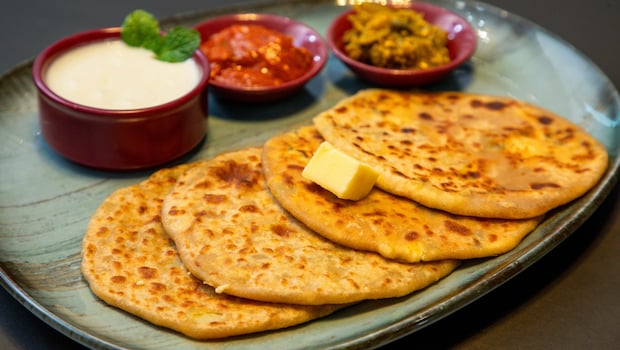Winter in India has its own quiet rhythm. The sunlight turns softer, the air takes on a polite chill, and kitchens begin to lean towards dishes that feel warm and grounding. It is the season when fresh produce arrives in heaps, especially peas, fenugreek, spinach, and crisp winter cabbage. Among all the cold-weather favourites, matar paratha keeps its place at the top. The slight sweetness of peas, the gentle heat of winter spices, and the comforting crunch of a freshly cooked paratha can turn a regular breakfast into something that feels both homely and seasonal. It works just as well for lunch or even an evening snack, filling the house with a cosy aroma. The charm of matar paratha lies in the small choices made during preparation. With winter vegetables at their peak, a few thoughtful steps can make your parathas taste brighter and feel more satisfying. These practical, winter-focused tips will help you prepare matar parathas that stand out with both flavour and freshness.
Also Read: Chunki Matar - A Famous Winter-Special Dish From UP That Can Be Your Next Favourite

Choose Fresh Seasonal Green Peas
Fresh winter peas make the biggest difference to the overall taste of your stuffing. They are naturally sweeter and softer than frozen versions.
- Use peas that have been shelled recently.
- Lightly steam or sauté them before grinding to help retain colour.
- Fresh peas blend smoothly and cook quickly, which keeps the texture light.
This simple step sets the stage for the spices and herbs you add later, and it gives the stuffing a brighter, more lively character.

Balance The Spices For A Rounded Flavour
Peas absorb flavour very well, so a balanced mix of spices works best.
Use:
- Roasted cumin
- Coriander powder
- Red chilli
- Black pepper
- A small amount of garam masala
Fresh ginger and green chillies add warmth and aroma suited to winter mornings. The goal is to support the sweetness of the peas without overpowering it, which helps the stuffing stay gentle yet flavourful.
Add Fresh Herbs For Aroma And Colour
Fresh herbs add a quick lift to the stuffing. Coriander, mint, and a small amount of fenugreek leaves bring earthy freshness.
- Finely chop the herbs so they spread evenly.
- Mix them into the pea mash after the spices.
- They add both fragrance and a natural green tone.
The herbs work like a bridge between the sweetness of peas and the warmth of spices, tying the stuffing together.
How To Prepare Or Store The Stuffing In Advance
If you prefer quick winter breakfasts, preparing the stuffing early can save time without affecting taste.
- Grind the peas and refrigerate for one day.
- Lightly sauté the mixture with ginger and green chillies if you want it to last longer.
- Store in an airtight container to prevent moisture loss.
- Warm it gently before use and add herbs at the end.
This method keeps the flavour stable and makes the morning routine easier, especially when cooking multiple parathas.
Prepare Soft Dough And Allow It To Rest
The dough must support the stuffing, so texture matters.
- Use whole wheat flour for strength.
- Add a teaspoon of oil or ghee while kneading.
- Rest the dough for at least 15 to 20 minutes.
Resting helps the gluten relax, which makes the dough easier to roll and stops the filling from breaking through. It also keeps the paratha soft even after cooking.
Cook On Medium Heat With Enough Ghee
Controlled heat ensures even cooking. Very high heat burns the surface while leaving the inside raw.
Use medium heat so the dough and stuffing cook together. A moderate amount of ghee on each side:
- Enhances flavour
- Keeps the paratha soft
- Adds richness that suits winter food
Here is a quick comparison to guide your heat levels:
| Heat Level | Result | Texture |
|---|---|---|
| High | Burns quickly | Inside stays slightly raw |
| Medium | Even cooking | Soft, crisp edges |
| Low | Dries out | Chewy and flat in flavour |
Medium heat remains the most reliable choice.
Also Read: Kadhi Lovers, Have You Tried Matar Ki Kadhi? Make It Today
Troubleshooting Common Matar Paratha Issues
Small challenges appear even for experienced home cooks. These quick fixes help:
- Stuffing leaks out: Dough is too thin. Roll slightly thicker or rest the dough longer.
- Paratha feels chewy: Heat is too low. Increase the temperature to medium.
- Stuffing tastes watery: Peas were not sautéed enough before grinding. Lightly cook them next time.
- Paratha turns dark too fast: Flame is too high. Reduce heat and add a touch of ghee.
These small corrections improve consistency across batches.
Serving Suggestions For Matar Paratha
Good sides complete the meal. Pair matar paratha with:
- Fresh curd
- Green chutney
- A spoon of homemade white butter
- Tangy pickle
A warm cup of masala tea or ginger chai adds a comforting winter note and rounds off the meal. These pairings suit breakfast, lunch, or even a late afternoon snack.
Why Matar Paratha Works So Well In Winter
Winter produce is at its natural best, and peas lead the charge with sweetness and colour. Combined with warm spices, herbs, and generous ghee, matar paratha becomes more than a seasonal dish. It turns into a small winter ritual that carries both comfort and familiarity. A simple recipe made with attention, it brings the flavours of the season directly to the table.







